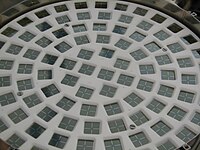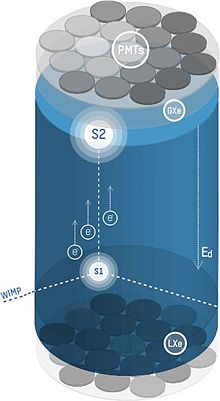XENON Dark Matter Project
Coordinates: 42 ° 25 ′ 14 ″ N , 13 ° 30 ′ 59.1 ″ E The XENON Dark Matter Project is an experiment to search for WIMPs , a variant of dark matter . The experiment is set up in the Gran Sasso underground laboratory. Several universities and laboratories around the world are involved in XENON. The scientific collaboration has been led by Elena Aprile ( Columbia University )since 2002.
functionality
The detector is a two-phase time projection chamber (dual phase time projection chamber, TPC) with liquid xenon (LXE) as a detector material and gaseous (Gxe) Xenon at the top of the detector. Liquid xenon is particularly suitable for searching for WIMPs because it has both a high density (3 g / cm 3 ) and a high atomic number (Z = 54). Photomultipliers (PMTs) are arranged at the top and bottom of the detector . When a particle interacts with xenon, scintillation and ionization occur . The prompt scintillation light is detected by the PMTs (primary scintillation light, S1 signal). The free charges from the ionization drift to the surface of the liquid xenon due to an electric field. If they enter the gaseous phase, they also generate scintillation light, which is detected by the PMTs (secondary scintillation light, S2 signal).
The position of the point of interaction can be determined from the time difference between the S1 and S2 signals and from the pattern with which the secondary scintillation light falls on the upper PMTs. This allows events in the center of the detector to be selected and background (which occurs more often at the edge of the detector) to be suppressed. The ratio of the size of the S2 signal and S1 signal provides information about the nature of the event. Since WIMPs are electrically neutral, they would primarily interact with a xenon core. The ratio of the size of the S2 signal and the S1 signal is smaller for these events than for particles that would interact with the electron shell of the xenon atoms ( gamma radiation or electrons ). This allows underground events to be filtered out.
Phases
XENON10
In the first phase XENON10 , 15 kg of liquid xenon were used. The construction of XENON10 started in March 2006; the first experiments started in October 2007. In this phase no evidence for WIMPs could be provided; the cross-section is thus less than 9 × 10 −44 cm 2 for an assumed particle mass of 30 GeV / c 2 .
XENON100

In the second phase XENON100 , 150 kg of liquid xenon are used, which results in a sensitivity that is around 50 times higher. The detector was put into operation in February 2008. The limit published in July 2012 with 2 × 10 −45 cm 2 for WIMP masses of 55 GeV / c 2 at a confidence level of 90% is currently the strongest limit on the WIMP nucleon cross-section.
XENON1T
The follow-up project XENON1T was set up from mid-2013 to November 2015 . Here 3500 kg of liquid xenon are used, of which the inner 2000 kg are used to search for dark matter. With the experiment, the investigated parameter space is to be extended to a scattering cross section of 2 × 10 −47 cm 2 with a WIMP mass of 100 GeV / c 2 . First results were published in May 2017, based on detector data from November 2016 to January 2017. No dark matter signal was found, the set exclusion limits are better than the best previous limits of LUX .
On June 17, 2020, a press release announced a not yet fully explained excess in the counting rate of the detector. With a probability of 3.5 sigma, this excess can be explained by solar axions , a possible candidate for dark matter. One hopes for more clarity by expanding the experiment with an even larger amount of xenon. The experiment extended in this way will then be called XENONnT.
Participating universities and laboratories
XENON10
- University of Columbia , USA
- Brown University , USA
- Rice University , USA
- Case Western Reserve University , USA
- RWTH Aachen , Germany
- Yale University , USA
- Lawrence Livermore National Laboratory , USA
- Laboratori Nazionali del Gran Sasso , Italy
- University of Coimbra , Portugal
XENON100
- University of Columbia , USA
- Rice University , USA
- University of Zurich , Switzerland
- Laboratori Nazionali del Gran Sasso , Italy
- University of Coimbra , Portugal
- University of California , USA
- Purdue University , USA
- Weizmann Institute for Science , Israel
- NIKHEF , Netherlands
- SubaTech , France
- Westfälische Wilhelms-Universität Münster , Germany
- Max Planck Institute for Nuclear Physics , Germany
- Shanghai Jiaotong University , China
- Johannes Gutenberg University Mainz , Germany
XENON1T
- University of Columbia , USA
- Rice University , USA
- University of Zurich , Switzerland
- Laboratori Nazionali del Gran Sasso , Italy
- University of Bologna , Italy
- University of Coimbra , Portugal
- University of California, Los Angeles , USA
- University of California, San Diego , USA
- Purdue University , USA
- Weizmann Institute for Science , Israel
- NIKHEF , Netherlands
- SubaTech , France
- LAL , IN2P3 , Orsay, France
- Westfälische Wilhelms-Universität Münster , Germany
- Albert Ludwig University of Freiburg , Germany
- Max Planck Institute for Nuclear Physics , Germany
- Johannes Gutenberg University Mainz , Germany
See also
Other large experiments to search for dark matter in the 2000s include: B. the SuperCDMS experiment in Sudbury or EDELWEISS in the Frejus tunnel.
Web links
- Official website (English)
- XENON100 website (English)
- XENON1T: a ton scale Dark Matter Experiment , Elena Aprile on behalf of the XENON collaboration, 2010 (PDF, 8.1 MiB, English)
- Lecture by Dr. Rafael Lang on the structure and function of the experiment (youtube) (German)
Individual evidence
- ↑ Homepage
- ↑ E. Aprile et al. (The XENON100 Collaboration): The XENON100 Dark Matter Experiment . In: Astropart. Phys. . 35, numbers 537-590. arxiv : 1107.2155 .
- ↑ E. Aprile et al. (The XENON100 Collaboration): Dark Matter Results from 225 Live Days of XENON100 Data . In: Phys. Rev. Lett. . 109, No. 181301. arxiv : 1207.5988 .
- ↑ New chapter in the search for dark matter Press release of the opening, accessed on May 14, 2017.
- ↑ XENON1T collaboration: First Dark Matter Search Results from the XENON1T Experiment
- ^ The World's Most Sensitive Dark Matter Detector Is Now Up and Running . May 24, 2017. Retrieved May 25, 2017.
- ↑ a b Observation of Excess Events in the XENON1T Dark Matter Experiment



